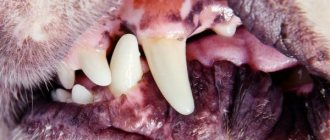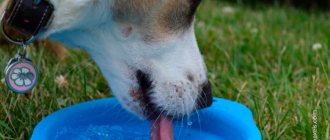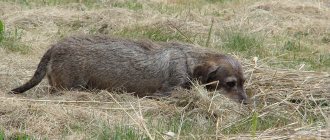Causes
Vaginitis in dogs occurs for various reasons. We will look at them now.
Juvenile vaginitis usually occurs in a dog that has not yet reached puberty. The main reason at this time is a decrease in estrogen levels in the blood. Against the background of this disease, the resistance of the genital mucosa to external irritants decreases. And this, in turn, of course, facilitates the process of introduction and further reproduction of pathogenic microflora.
Outgoing inflammation of the uterus is also the cause of vaginitis in dogs.
The next cause of the disease is trauma to the mucous membrane during sexual intercourse, during childbirth, and during gross medical procedures. The gateway for the penetration of pathogenic bacteria (enterococci, staphylococci and others) is precisely injured tissue.
Why else does vaginitis occur in dogs? This disease can appear when the animal’s immunity is reduced due to stress, poor hygiene, or an unbalanced diet. Infection with worms can also cause vaginitis. Another reason is the improper use of antibiotics. Because of this, the normal microflora of the vagina is disrupted, dysbacteriosis appears, which leads to vaginitis in dogs.
Bacteria can also enter the animal's mucous membrane during mating.
Vaginitis in dogs: symptoms of the disease
Characteristic signs of this disease are a swollen vulva and redness of the mucous membrane. Another symptom is that an inflammatory exudate is released from the dog’s loop. It can be of different colors (white, greenish, etc.).
Other signs of the disease:
- the fur around the genitals is glued together;
- itching (scratching and biting of the vulva is observed);
- the animal behaves restlessly;
- the appearance of blood or pus is possible;
- Sometimes there is an increase in temperature.
How does vaginitis manifest?
The symptoms of vaginitis in a dog directly depend on the type of disease characteristic of a given case. There are juvenile, serous, catarrhal, purulent, gangrenous and fibrous variants of the development of pathology.
Juvenile
Signs of this vaginitis can be seen even in a puppy, starting from 2-3 months of age. Pet owners notice the appearance of scanty creamy or abundant purulent discharge from its vagina, which is why the dog often licks itself, and in some cases tries to rub its genitals on the floor or other objects. Otherwise, juvenile vaginitis does not change the animal’s behavior in any way: there is no refusal of food or depressed state.
Serous
The serous form is also characterized by the appearance of discharge from the loop, but it usually appears as whitish or yellowish accumulations of mucus that do not cause increased discomfort in the dog. As in the previous case, the animal can actively lick itself without changing its other habits.
Catarrhal
This variety is characterized by a cloudy, colorless or watery exudate, and upon careful examination of the dog's external genitalia, you may notice small ulcers and hemorrhages on the surface of the loop, as well as a characteristic sour odor. Sometimes there is a slight swelling of the vulva, but this does not bother the dog too much.
Did you know? The most famous long-lived dog is deservedly considered a terrier mix named Max from Louisiana (USA). He lived for 29 years and died in 2013.
Purulent
Purulent vaginitis is often a consequence of catarrhal inflammation from streptococcal or staphylococcal microflora. In this case, a viscous, yellow-green discharge with an unpleasant, pungent odor appears from the dog’s vagina. In neglected situations, they partially remain on the surface of the bedding, profusely coming out of the bitch’s loop.
Gangrenous
The most severe form of the disease, characterized by melting of the vaginal mucosa under the influence of pyogenic microflora. In addition to the purulent modified secretion, dead tissue of the mucous membrane is also released from the dog's loop, from which a sharp putrefactive odor emanates. Doctors do not undertake to predict the success of treatment in such advanced cases, because sometimes even death is possible.
Forms of the disease, signs
An inflammatory process may occur in the form of catarrhal-purulent, phlegmonous, serous and diphtheritic vaginitis. Now we will describe exactly how each type manifests itself.
- Phlegmonous type. Gray or brown discharge with a clayey odor may come out of the vagina. It is also possible that remnants of various tissues may appear.
- Catarrhal vaginitis manifests itself as cloudy, colorless and watery discharge. On the mucous membrane you can notice hemorrhages and ulcers (small in size).
- The serous appearance is characterized by yellow and translucent discharge.
- Juvenile vaginitis in dogs. Characterized by translucent cream-colored discharge.
- Chronic vaginitis is manifested by yellow exudate, its consistency resembles sour cream.
- The diphtheritic type can be identified by the following symptoms: bloody discharge with an unpleasant odor, elevated temperature.
- Purulent-catarrhal vaginitis is characterized by thick discharge with pus. Multiple erosions and ulcers can be seen on the mucous membrane.
Forms of balanoposthitis in dogs
Depending on the current symptoms and the rate of development of inflammation, it is customary to distinguish several forms of pathology.
This:
- Simple form. It is characterized by the presence of erosive areas on the mucous membrane of the head of the penis and foreskin.
- Erosive balanoposthitis. In this case, the dog experiences the formation of whitish growths, which then burst. In their place, eroded areas form.
- Pustular-ulcerative form. The appearance of purulent discharge and ulcers is typical for it.
- Acute balanoposthitis. Local inflammations form on the mucous membrane of the foreskin. There is an increase in local lymph nodes. Body temperature rises.
- Gangrenous format of inflammation. It is accompanied - in addition to the characteristic symptoms - by high body temperature and general weakness of the animal.
- Chronic balanoposthitis. There is cracking of the mucous membrane of the head of the penis, as a result of which the dog experiences constant pain. Scarring of the foreskin causes phimosis. There is an increase in local lymph nodes and an increase in temperature.
There are several types of balanoposthitis in dogs.
Treatment of the disease. What methods are used?
Of course, you need to start treating vaginitis in a dog as early as possible in order to avoid complications. But this must be done under the supervision of a veterinarian.
Typically, juvenile vaginitis in dogs does not require treatment. It usually goes away after the first heat begins. Other veterinarians offer their own treatment methods. It is necessary to administer estrogen preparations in a reduced dosage for three days (the active substance is required from 0.1 to 0.6 mg per injection).
Treatment of vaginitis in dogs with hormonal drugs is rarely used, since such measures do not always give a positive result, but a negative effect (hormonal imbalance may further intensify) manifests itself in almost every case.
To prescribe the correct treatment, a swab is taken from the dog’s vagina. He is sent to the laboratory. There, various tests are carried out to determine the sensitivity of the resulting microflora to various antimicrobial agents. The choice of drugs depends on the results.
For mature animals, local treatment without general antibiotic therapy is almost never used. These drugs are used for high severity of the disease (with phlegmonous and diphtheritic forms).
To stop the pathological process in purulent catarrhal and catarrhal forms, ointments that have anti-inflammatory and bactericidal properties are applied to the mucous membranes. To make it easier to apply the product, use plastic spatulas or a syringe.
Help, the girl's loop is very inflamed - Yorkshire Terrier!
1. Yorkshire Terrier - female - 19 months. 2. Nutrition - food. 3. All vaccinations have been given. 4. Yesterday morning after a walk, she began to hide under the furniture, hides, does not eat food, does not refuse treats, but most importantly, her loop is very swollen (all white and red (I even thought that pus has accumulated inside)), constantly licks herself , scratches appeared on the skin on the withers - yellow-brown spots - scabs. Today my little girl is vomiting and also hiding.
a) appetite - weak b) water intake - normal - as always b) activity - weak c) urination - stable d) stool - stable e) vomiting - frequent, but today I haven’t eaten anything yet. f) temperature - 38.6 Now we went to the doctor. The doctor said the temperature was 38.6 - good, the loop was inflamed. The doctor said that without tests he could not understand what happened, whether it was the beginning of the 2nd heat, or cystitis, or even inflammation of the uterus. They told me to collect a urine test and do an ultrasound of the uterus. But we haven’t made an appointment for an ultrasound yet, there are too many people. Tell me how I can relieve the inflammation of the loop, and remove allergic scratching on the withers (I think it’s an allergy, we had this a year ago - then they did a soscope - they said everything was clear). They prescribed exokan (in cubes), I think that’s what it’s called, and then all the spots and scabs from scratching went away.
Just read it. similar cases
https://www.zoovet.ru/forum/?t > In dogs, vaginitis is expressed in various discharges from the loop. Owners pay attention to white, greenish, mucous discharge or sticky fur around the genitals. There is itching, irritation, and intense licking of the loop. In rare cases, general malaise with fever may develop.
The disease is associated with the activation of microflora in the dog’s vagina. This is usually due to weakened immunity, previous illnesses, and less often after childbirth. In young dogs, vaginitis can develop during puberty, as well as with increased levels of female sex hormones in adult dogs.
When examining the animal, the veterinarian must determine the severity of the disease and its cause. To do this, laboratory blood tests, vaginal smear analysis, and an ultrasound are required to rule out endometritis. Sometimes it is necessary to examine the level of sex hormones or perform a vaginoscopy. In case of bloody discharge, it is necessary to exclude erosion of the cervix, ulcers of the vaginal mucosa and venereal sarcoma of bitches.
Treatment for vaginal inflammation depends on the cause of its occurrence and the severity of the process. In mild cases, you can limit yourself to washing the vagina with herbal decoctions. If there is excessive purulent or bloody discharge, systemic treatment with antibiotics, immune drugs, and local disinfectant solutions is required. If the endocrine cause of vaginitis is determined, hormonal levels are corrected.
In any case, treatment should be prescribed only after an accurate diagnosis has been made.
ZooForum: Swelling of the loop without estrus – ZooForum
(others can give advice in a PM, indicating that the advice is not given by a veterinarian. But the forum is not responsible for THESE advice.)
Swelling of the loop without estrus
Hello! I have similar problems with Elena. L. The situation is this. A female French bulldog, 8 months old, has not been in heat yet, but the loop has increased greatly (as in the height of heat), the discharge is watery, cloudy. Her condition is excellent, she plays, is cheerful, eats and drinks as usual. What is this - vaginitis? Pyometra? or is she about to go into heat? I’m very worried. I went to the veterinarian and they immediately said - pyometra, bring me in and we’ll operate! We don’t do tests, in general the level of veterinary care is Neanderthal. I’m generally silent about ultrasound. Help determine the diagnosis, please. Or should I go for surgery?
No operation without examination! Ultrasound and blood tests. If you live in Moscow, contact Zoovet, they will do everything right away in one day.
How long ago did she start having discharge? Is the loop just swollen? Are you flushed or have a rash? Is the noose bothering the dog? (itching, licking, does it rub on the carpet or floor?)
We recommend reading: How to Recognize Worms in Cats
Where do you live? Is there absolutely no way to get vaginal cytology? (smear from the side wall of the vagina) Blood test for progesterone? (can be done in a human laboratory).
Thank you very much for your response. Regarding the tests, I will try to make arrangements at a human hospital, because... Our veterinary medicine for dogs is undeveloped. I live on the southern coast of Crimea, in a small town and we don’t have a good clinic.
The loop began to swell about 7-10 days ago, there is no itching. Regarding the discharge, there is no such thing as flowing. It just accumulates and hangs like a small drop, cloudy (fawn-grayish), liquid like water. If you press the loop down from the tail, stands out a little more. In the morning it dries out and sticks together a little around the loop. The loop is now very swollen, when it runs it’s all t
You have JavaScript disabled. Some functions may not work. Please enable JavaScript to access all features.
ALL LINKS TO THIRD-PARTY RESOURCES IN TOPICS, MESSAGES, PHOTOS, SIGNATURES AND USER PROFILE ARE PROHIBITED. IF YOU ARE UNAUTHORIZEDLY POSTED, THE LINKS ARE REMOVED AND THE USER IS BLOCKED. ALL QUESTIONS ABOUT PLACEMENT OF ADVERTISING -
You need to be examined by a doctor, although it should be noted that the causes of pathological disorders of ovarian function cannot always be identified during examination.
It is impossible to make any assumptions about the cause of the delay without an examination. We advise you to see a doctor if estrus does not start within the next month.
At what age should estrus begin? If it’s not difficult, please answer from what age and up to what age? We are 8+ months old.
At what age should estrus begin? If it’s not difficult, please answer from what age and up to what age? We are 8+ months old.
We are almost 11 months old, and I cannot accurately answer the question - whether we were in heat. Once every 9 months I noticed two tiny droplets on the diaper and whisker. No more signs. Neither behaviorally nor visually. Males follow us constantly.
We are almost 11 months old, and I cannot accurately answer the question - whether we were in heat. Once every 9 months I noticed two tiny droplets on the diaper and whisker. No more signs. Neither behaviorally nor visually. Males follow us constantly.
Today is May 2, but the loop is not getting smaller and there is still blood discharge (though light brown). Is it even normal that it takes so long??
Your dog’s heat has been prolonged, which may indicate both hormonal imbalances and an inflammatory process. You definitely need to get examined.
It's not a month yet, but it's already a quarter
We don’t know, we are keeping our first dog, we read that the loop increases in size during heat, but then what sticks out of there, a pink ball. What is this? The dog behaves calmly, as if nothing had happened, licked it and continued playing. 1319
I'm not a pro, but if my bitch's noose looked like that, I would immediately go to the hospital. And in general, where did you get the idea that this is estrus, maybe some kind of inflammation has begun and blood has already begun to ooze. and in general, the noose of a bitch in heat looks completely different, the “balls”, sorry, don’t come out at all, and my advice to you is to see a doctor URGENTLY.
Yes Yes Yes! To the doctor! This is not normal, and don’t delay! If it’s vaginal prolapse, you also need to prevent the mucous membrane from drying out - put a damp rag on a loop - and put your hands on your feet!
Be sure to write how she is doing after the operation, and everyone themselves must have been worried. Well done for taking it right away. hang in there.
My pug had exactly the same thing, but she was already 5 years old at that time, the doctor said either to breed her immediately or to sterilize her, the mating didn’t work out, so she sterilized her.
Visually similar to vaginal hyperplasia. This is a dishormonal disease, and it is especially young females of giant breeds who are susceptible to it during the period of heat (I personally have only seen this happen once). Hyperplastic tissues are excised surgically under general anesthesia.
The uterus is removed (this is correctly called an ovariohysterectomy) in order not to cause a relapse of the disease in the next heat.
My pug had exactly the same thing, but she was already 5 years old at that time, the doctor said either to breed her immediately or to sterilize her, the mating didn’t work out, so she sterilized her.
Dana, where to knit? In principle, no mating can work. Well, what if, purely theoretically, it worked out. then the uterus would fall out. If the prolapse is not severe—about the same as in Realist’s dog, usually—the vagina is realigned by hand; if it is severe, as I already wrote, resection is definitely necessary.
- dog's age;
- breed characteristics;
- hormonal changes.
Causes
Vaginitis occurs as a consequence of the following diseases or pathological conditions:
- injuries during mating or whelping;
- violation of sanitary and hygienic standards of detention;
- unbalanced feeding or consumption of spoiled foods;
- side effects of medications;
- chronic infections of internal organs;
- allergic reactions;
- ovarian hypofunction;
- hormonal imbalance after sterilization;
- infection through accidental mating or mating with an infected dog.
Types and clinical symptoms
When examining the external genitalia, swelling and redness and skin rashes on the private lips are noticed. The bitch is lethargic, eats poorly, and develops intermittent fever, characterized by a rise in temperature in the evening and a drop to normal in the morning.
The infection enters the vagina from the outside - from the anus or hair surrounding the vulva, or from the urinary tract. Vaginitis is most dangerous during the period of pregnancy. Infection can lead to abortion, stillbirth, or non-viable babies.
There are the following types of vaginitis:
- Serous - characterized by the release of liquid or mucous translucent excreta, which, with the development of the inflammatory process, acquires a creamy tint.
- Catarrhal - characterized by a sour odor of cloudy white discharge.
- Purulent - viscous, yellowish with green, foul-smelling contents are separated.
- Fibrinous - films of precipitated fibrin protein settle on the walls of the vagina. The films should not be removed as this will cause ulcers to open. This form of the disease is characterized by copious discharge from the loop.
- Gangrenous - tissue death and fragmentation occurs. A foul-smelling ichor with pus and pieces of necrotic mucosa flows out.
As a type, juvenile vaginitis is isolated, which is recorded in teenage puppies. In most cases, the pathology goes away on its own after the first heat.
Pathological causes
These include:
- False pregnancy. If fertilization does not occur, but the female’s mammary glands swell and discharge from the genitals begins, this is caused by a hormonal imbalance. This condition can develop 5-8 weeks after estrus.
- Vaginitis . The inflammatory process in the vagina causes increased secretion of mucus. This is usually a white discharge from the dog's loop, accompanied by an odor and itching. In animals before puberty, the disease can be caused by hormonal imbalances and manifest as yellowish discharge.
- Pyometra . Purulent inflammation of the uterus occurs in 2 forms: in the first, pus is released out through the genital tract, in the second, it lingers in the uterine cavity, poisoning the body or leading to rupture of the organ, which can be fatal.
- Endometritis . Inflammation of the lining of the uterus often develops due to an imbalance of hormones, as a result of which the walls of the organ thicken and more mucus is produced. The addition of an infection entails discharge with pus, refusal to eat, and fever. The disease in the chronic stage often does not give a clear clinical picture, but can lead to infertility.
- Neoplasms . Venereal sarcoma is the most common cancer of the reproductive organs in dogs.
Prevention
To prevent the development of vaginitis, it is necessary to maintain the body’s immune defense at the proper level and prevent the occurrence of infections. The following rules must be followed:
- Comfortable keeping and adequate feeding.
- Carrying out vaccinations in accordance with the vaccination plan.
- Quarterly deworming and regular destruction of ectoparasites.
- Preventing accidental matings.
- Monitoring the health status of both partners before mating.
To protect your pet from vaginitis and other diseases, preventive examinations should be carried out every six months.
Read us also on VKontakte and Odnoklassniki. We invite you to our communities.
Harmless reasons
If a dog licks a loop during heat, then this is considered normal and nothing should be done.
need to. Especially if this is the first heat in her life. The amount, nature and duration of discharge is individual. On average, estrus lasts from 2 to 4 weeks, 1-2 times a year. During this period, some owners prefer to use special panties to avoid problems with blood throughout the apartment, but as practice shows, this is an ineffective method. It is perfect for owners of English bulldogs who cannot reach their dog's loop and do not have the opportunity to perform the hygiene procedure on their own. But even they constantly take off their panties and lick them.
When a dog is licking a snare without being in heat, it is recommended to conduct a thorough inspection of the groin area. In the summer, allergies to various plants are considered a common occurrence. And since the pet touches them mainly with its stomach, its maximum manifestations are in the area of the mammary glands, navel and groin. Hence the appearance in this area of red spots, small rashes and itching, which bring discomfort to the animal. This is why the dog begins to scratch and lick the loop area if there is even the slightest irritation there. It is recommended to treat this area with a solution of chlorhexidine and lubricate it with baby cream (works great for minor manifestations of allergies).
Injuries. The four-legged animals try to lick even a small wound that the owner may not notice. There are cases when such wounds appear nearby or on the loop itself. If there is no infection, then everything will heal within a couple of days.
The Dog Has Redness Around the Loop
Diaper rash around the loop. The loop is swollen and red
Asichka777
: Our girl (6 months old) has a swollen and reddened loop, it doesn’t bother her too much, only when you touch it she starts to lick it. Pees as usual, urine without visible changes. Please tell me what this could be and what to do?
Yulenka
: Dear bulldogholics! Please tell me what this is. The girl’s pussy began to “sink” into the skin fold when she was brought in at 2 months. This didn’t happen, it started at about 3. Especially when she pees, you can see that it itches, she goes to lick it, urine gets into the fold and the skin turns red, like diaper rash in a child. I apply zinc ointment, the redness goes away, but this area still bothers her. And it seems to me that the place closer to the tail (I don’t know what it’s called) is a little swollen. Maybe this age thing will pass? I’m posting photos, I apologize in advance for their “intimacy”
We recommend reading: How to make cat claws for climbing trees
fanat
: A dog’s pussy is usually called a LOOP. All folds on the bulldog's body, including this one, must be wiped with CHLORHEXIDINE (person)
citr
: But to the point, this location of the loop also seems strange to me. My dog looks different. Let's say traditionally. And it doesn’t depend on age, as it was with the puppy, and now, with the adult auntie.
Yulenka
: fanat writes:
LOOP
Era, yes, I know Stepped something I meant the back part of it, suspiciously like that. What do you think?
Yulenka
: fanat I wiped it with Chlorhexidine, which is always necessary - I didn’t know this, my previous bitch didn’t have this, although she wasn’t a bulldog. But it was zinc ointment that helped with redness
fanat
: Zinc ointment is also good. Here, it seems to me, it’s just an individual structure (like with people). Some bitches have the loop outward, and some have it hidden under the “visor” between heats.
Yulenka
: fanat Thank you! We'll watch. Maybe this will go away later? At first it wasn't.
fanat
: Or maybe it won’t work. But it's not fatal. Just keep an eye on it, especially in the summer.
Irisha1105
: Yulenka My youngest has a similar structure, only not as deep, and the folds also always have to be wiped out. I've never encountered this before. Now after going outside, I always wash it well and, if necessary, wipe it with chlorhexidine. Now it’s less, but in the summer I wiped it every day.
Yulenka
: fanat Irisha1105 Thank you!
Oza
: For such a fold, the baby ointment for diaper rash DESITIN is well suited.
Nusha
: Oza writes:
For this crease, the baby diaper rash gel DESITIN is well suited.
Yulenka, I absolutely agree with Oza, I’ve been using DESITIN for about 10 years now, and it can even whiten the tear ducts of little white Frenchies. Very good cream.
Yulenka
: Oza writes:
baby ointment for diaper rash DESITIN
haven’t even heard of this one. Thank you
Oza
: The veterinarian advised me to treat the folds with it. Every few days I wash out any remaining desitin from the crease with chlorhexidine and reapply a layer of desitin. To your health.
N.D
: In heat. This kind of thing happens to girls.
Yulenka
: fanat I wiped it with Chlorhexidine, which is always necessary - I didn’t know this, my previous bitch didn’t have this, although she wasn’t a bulldog. But it was zinc ointment that helped with redness
Possible diseases
Despite all of the above, the possibility of developing the following diseases cannot be excluded:
- Cystitis. It tends to be chronic and have frequent relapses. Affects dogs of all ages. A common cause of occurrence is hypothermia. Symptoms include increased frequency of urination, blood in the urine and scarlet discharge from the loop, which the dog tries to lick. At the initial stage, it is successfully treated with canephron and no-shpa. In advanced cases, you cannot do without an antibiotic.
- Vaginitis. Common among dogs of all ages. For example, before their first heat, puppies often have a light yellow, odorless discharge from the loop. If the animal reaches the loop, then it can lick them. There is nothing scary about this. In most cases, juvenile vaginitis does not require treatment, since its nature is associated with the activity of the immune tissue of the vagina, and not with infection. Washing the loop with miramistin and chlorhexidine is indicated. The situation with vaginitis in adult dogs is more complicated, since it is caused by bacteria that provoke the appearance of purulent discharge from the loop with an unpleasant odor. In addition to everything else, itching is added, forcing the dog to lick and bite the groin area more than usual. Here, qualified diagnostics are already needed, including taking a smear from the vagina and determining the nature of the infection. Then antibiotics (amoxilav) are prescribed.
- Pyometra. One of the most dangerous diseases associated with the symptom we are interested in. It can be closed or open. It occurs most often in adult dogs that have not been sterilized. Throughout life, during each heat, the animal's uterus opens, which makes it vulnerable to various types of bacteria. Symptoms include the appearance of purulent, foul-smelling discharge from the loop, which the dog tries to lick. Vomiting and bloody stool may be present. Treatment is only surgical with removal of the uterus and ovaries. As practice shows, conservative methods are ineffective and can lead to aggravation of the disease. In the end, you will still have to operate, only the pet will be older, and with age the risk of recovery from anesthesia always increases.
I would also like to separately dwell on cases where in bitches the duration and amount of discharge from the loop increases with age. If you notice that your pet does not have time to lick the discharge, then it is better not to delay a visit to the veterinarian. And do not wait for exacerbations, under normal conditions, do an ultrasound, donate blood and urine. It is better to assess the risk of developing pyometra and other dangerous diseases associated with the uterus and ovaries in a calm situation.
Bloodless estrus in dogs
Quite often, owners of domestic dogs are faced with the so-called bloodless estrus. As such, bloodless estrus, according to experienced dog breeders, is most often a feature of small, decorative breeds of dogs. Bloodless estrus can occur in different ways - in some cases, the animal has all the signs of the bitch's rut, such as changes in the animal's behavior, swelling of the loop, but there is no bleeding, or there is some, but so scanty that she licks them and the flow occurs for the owner is unnoticed. Another option is the absence of all signs of rutting, but the heat passes.
If the owners have suspicions that they are in heat, but are not completely sure about it, they should be as careful as possible while walking to avoid an unplanned mating. If mating is planned, laboratory tests such as a blood test and a vaginal smear will help determine whether the bitch is in heat, in the absence of external signs. However, the owner must understand and remember that a bloodless rut in a bitch is an unnatural process for the animal, and requires examination by a veterinarian.
Another danger for the animal is the bitch’s ongoing heat. In this case, a visit to the doctor is immediate, as is a full examination and tests, prescribing a course of effective treatment. The reasons that provoke a protracted rut and estrus in a dog can be different - from hormonal imbalance to vulvovaginitis, the development and growth of a tumor. This problem is most often diagnosed in an adult bitch, but if this is the animal’s first or second heat, then we are talking about prolonged juvenile proestrus. In this case, the tests will not show deviations from the norm, the animal is cheerful and active, since for the first or second heat, for the most part, this phenomenon can be the norm.










